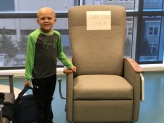Vaccine-boosted CAR T cell therapy for high risk neuroblastoma

Neuroblastoma is one of the most common solid tumors in pediatrics. High-risk neuroblastoma has dismal outcomes, with only a ~50% cure rate. Patients whose cancer comes back after therapy are almost incurable. Therapies used to stimulate a patient's own immune system to fight cancer have positively changed the way we treat pediatric cancer. One therapy in particular, called chimeric antigen receptor (CAR) T cells, engineer a patients own immune system (T cells) with a receptor (CAR) that allows them to find and attack cancer cells. While this approach has been very successful for some pediatric leukemias, solid tumors such as high-risk neuroblastoma are less responsive to this therapy. Namely, as opposed to leukemia which circulates in the blood, neuroblastoma is a large, solid tumor with many other cell types that prevent the CAR T cells from penetrating the cancer and surviving long enough to kill the cancer cells. Vaccines stimulate immune cells in lymph nodes (our immune organs) to recognize and fight pathogens including viruses, bacteria, and even some cancers. Normally vaccines are designed to stimulate new T cells to recognize disease. But, using a vaccine to stimulate CAR T cells that we have given to a patient is one strategy to give activation and reinforcement signals to penetrate the tumor better and survive long enough to prevent the tumor from coming back. We have developed a model to see if a vaccine will improve CAR T therapy in high-risk neuroblastoma.
Project Goal:
Studying the function of chimeric antigen receptor (CAR) T cells in animal models is necessary before experimenting with a new therapy in humans. We understand the immune system of mice very well, and some groups have shown using adult tumor models in mice that using a vaccine to stimulate CAR T cells increases the number and lifespan of CAR T cells in the mouse, increasing their ability to kill tumor cells. This vaccine strategy has not yet been tested in any pediatric cancer model. We have created a new neuroblastoma mouse model that has a fully functioning immune system and tumors that can be recognized and killed by both human and mouse T cells engineered with a neuroblastoma-specific CAR. We plan to show how the use of vaccines given to mice will (1) increase the lifespan of CAR T cells circulating in their blood and living in their immune system organs, (2) be better able to kill cancer growing in these mice with lower doses of T cells, and (3) prevent relapse, or the cancer coming back. For study this, we have very clever ways of looking at tumors under the microscope to determine how T cells are better able at finding and penetrating the tumor and if they're able to recruit other important normal immune cells to help kill the cancer and prevent it from coming back. Results of this project will be critical in helping improve immune cell therapy for neuroblastoma and other pediatric cancers. We expect the results of this study to allow us to open a new a clinical trial.

